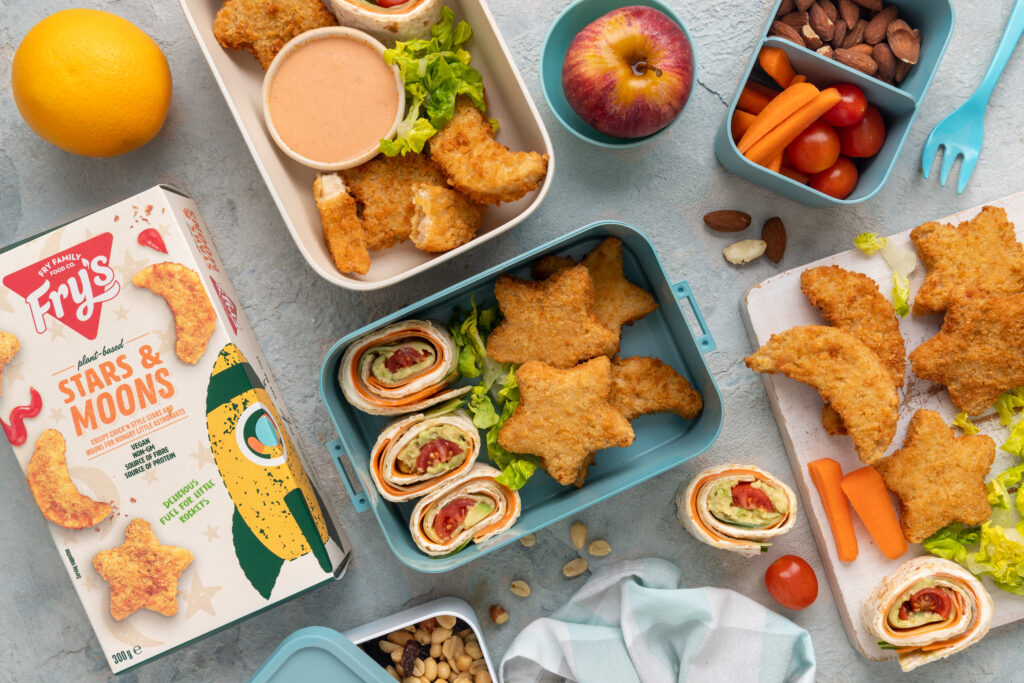Optimize your plant-based sales by targeting the flexitarian market
Contrary to popular belief, flexitarians1 are the chief target consumer group for plant-based foods – not vegans or vegetarians. Why? Because flexitarians (and reducetarians) represent almost half of consumers in many countries and account for most plant-based purchases.2
Therefore, shifting your focus from the niche vegan market (less than 4% of consumers) to flexitarians can open up a market over 10 times larger.
Flexitarians also represent the demographic experiencing the fastest growth, outpacing the uptake of both vegan and vegetarian diets. Interestingly, 57% of flexitarians say they want to gradually eliminate meat from their diets, showing a keen interest in increasing their consumption of plant-based foods.3
In this article, we’ll share actionable insights for food service businesses, brands and producers, and retailers looking to reach this growing audience.
1. Retailers
Supermarkets, discounters, and grocery stores can be overwhelming places – both in-store and online. With so many products available, shoppers face decision paralysis, which often causes them to revert to familiar choices. So, how can retailers encourage flexitarian consumers, who are open to plant-based foods, to opt for these products instead of animal-based ones? It comes down to the curated shopping environment and the products available. Let’s take a closer look.
Choice architecture and nudging
Shoppers are constantly influenced by the environments in which they shop – but this isn’t a forceful or obvious influence. Instead, shoppers are gently encouraged to make decisions based on what is around them, such as the location, positioning, and pricing of products, promotions, discounts, offers, and marketing materials.
By carefully understanding how these elements work together, retailers can create an environment where shopping decisions can be influenced. This is known as ‘choice architecture’ – “the practice of influencing choice by organizing the context in which people make decisions.”4
A ‘nudge principle’ is “any aspect of the choice architecture that alters people’s behavior in a predictable way without forbidding any options or significantly changing their economic incentives.”5

“People who call themselves vegan or vegetarian already know what food they will eat or buy before entering a canteen or retailer. But flexitarians have not yet made their choice. Meat-eaters don’t really think about vegan or veggie alternatives, but flexitarians are open-minded to them. Hence, they are the main group we should focus on using food environments. Vegans won’t change anything in their main choice, but flexitarians do every day.”
- Display plant-based products next to animal-based products online and in-store: At ProVeg, we recommend utilizing an ‘integrated-segregated’ approach for product positioning, whereby plant-based products are grouped together but positioned within animal-based product aisles. This merchandising technique and nudge, which takes plant-based products to where the most potential shoppers are, normalizes plant-based products, demonstrates their utility, and makes it as easy as possible for consumers to find them. Mixed eaters are less likely to venture into separate plant-based aisles. By grouping plant-based products in a segregated ‘vegan’ aisle, you group them as ‘only for vegan consumers’ and not for mixed-eaters, nudging them in the wrong way.
- Increase the visibility of plant-based products: Flexitarian consumers don’t want to work too hard to find their favorite alternatives, so make products stand out in aisles and on shelves. ProVeg recommends the following to increase product visibility:
- Signage throughout the store advertising plant-based ranges and related offers
- Pop-up taster stations where visitors can sample your plant-based products
- Plant-based items placed at the front of your store and the end of aisles
- Plant-based products positioned on shelves at eye-level
- Clear branding or promotional messaging on shelf-edge label strips
- Shelf-dividers detailing categories
- ‘Wobblers’ (printed shelf markers that wobble) or ‘bus stops’ (double-sided printed shelf markers or wobblers that highlight a product, offer or price).

- Provide more and better plant-based options: The worst thing a retailer can do is supply poor-tasting options, so ensure that the ranges you offer are the best. This is crucial since taste is the top motivator for plant-based purchases. Track and increase their ratio compared to animal-based products to normalize plant-based options. Get in touch with [email protected] to learn more about our Protein Tracker.
- Sell plant-based products at the same price as animal-based products (or cheaper): Nearly half of people would choose plant-based foods if they were cheaper than their animal-based equivalents. Based on our research, many retailers and manufacturers charge a 30–40% margin on their plant-based products, compared to just 4–8% on animal-based equivalents. Why? Historically, the small vegan segment of consumers has been willing to pay a high price for their values. Mainstream consumers are time-poor and overloaded with decision fatigue. Price is a strong motivator and a fantastic way to get their attention. Reducing margins and lowering prices can attract more of the flexitarian mass market. This will drive turnover and increase your overall revenue. In 2023, Lidl Germany price-matched its own-brand Vemondo range with comparable animal-based options (and has reported a 30% increase in sales!). Since then, Kaufland, Aldi Sud, Penny, and BILLA have announced similar initiatives.
2. Brands and producers
When your plant-based product is on a shelf with a hundred other products – animal-based and plant-based – how do you encourage a consumer to pick it up? It stems from good branding, marketing, packaging, and of course, a great-tasting product.
Product formulation
- Optimize taste and texture: The taste and texture of plant-based meat and dairy products are pivotal to their success. 73% of plant-based products are purchased by omnivores and flexitarians whose primary motivation for purchasing and consuming plant-based foods is taste. The ingredients you select are vital – they must allow for the same juiciness, creaminess, flavor, and/or bite as the food you want to replicate. Continued product reformulation and development are paramount. Invest in the latest technology to ensure you produce alternatives that cater to consumers’ preferences and keep up with the competition.
- Account for comfort and familiarity: To ensure broad appeal, focus on plant-based products that replicate consumer favorites of animal-based products (e.g. scrambled tofu instead of eggs, ‘chick’n’ pieces instead of chicken). Almost two-thirds of consumers prefer products similar to foods they already know.6 At the same time, many consumers are looking to reduce their meat intake. This creates a natural opportunity for plant-based alternatives to satisfy consumers’ traditional taste and texture requirements while meeting flexitarian preferences for healthier and more sustainable foods.
- Look to legumes: The latest Smart Protein consumer survey found that 53% of European consumers intend to increase their consumption of legumes.7 Utilize this insight by using more legumes in your formulations and develop delicious products that are in line with flexitarians’ intentions.
- It needs to be convenient to use: Mixed-eaters want convenience. To appeal to them, your product should:
- Use cooking methods that match the preparation of the conventional product.
- Use portion sizes tailored to your target segment (e.g. ready-meals are usually bought by homes with two people, while whole-cuts are bought by larger families).
- Balance taste and texture with nutrition: It’s also important to keep ingredient quality and nutritional values in mind. Streamline ingredient lists, where possible – consumers may not always scrutinize the ingredient list, but it remains a critical element in building trust. Keep it concise, using high-quality, kitchen-recognisable ingredients (whenever feasible). Highlight recognizable ingredients on the packaging. This approach enhances transparency and resonates with health-conscious consumers wanting to know what they eat.
Marketing
- Emphasize taste: Because consumers are primarily driven by taste, plant-based brands must win over their taste buds before winning over their wallets. “Marketing plays a key role in consumer acceptance,” explains Jeanine Ammann, Research Associate at Agroscope. “To reach flexitarian consumers, it’s better to promote a vegetarian dish as tasty instead of highlighting that it is vegetarian.” Remember, you’re battling flexitarian fears of missing out – it’s super important to counter this with positive messaging about the taste benefits of plant-based food, so focus on indulgence. On marketing materials, prioritize the taste credentials of your product, over everything else.
- Collaborate with social media influencers: Connecting with influencers who match your brand values can increase your visibility, expand your market reach, and reinforce your brand’s identity and credibility. Aim to build meaningful relationships with influencers on social media, then give them some free products to sample. They’ll spread the word about you to their followers if you’re a good fit. This will open the door to further collaborations, such as creating shared recipes or co-hosted launch events. These efforts will cumulatively grow your brand’s audience and market share – with up to 11 times more impact than conventional social-media advertising. For detailed examples of brands and retailers using these methods effectively, check out our white paper, How to work with influencers to reach key consumers.

- Collaborate with food service venues and chefs: By partnering with a food service venue or a chef, you allow flexitarians to see and sample your product(s) – professionally prepared. This alleviates consumer uncertainty regarding product utility and taste, allowing them to sample it at its best.
- Curate a strong and authentic brand: Flexitarians seek authenticity and transparency in their chosen brands. A plant-based brand with a strong identity that reflects its commitment to sustainability, ethical sourcing, and health can resonate with flexitarians who prioritize these values.
- Share engaging content: Create engaging and informative content about sustainable living, recipes, and the benefits of plant-based foods to connect with flexitarian consumers on a deeper level. Whether through social media, blogs, or other channels, brands can use content to reinforce their identity and build a community of like-minded individuals.
Packaging design
- Don’t use negative descriptors: Research shows that terms like ‘meatless’ or ‘meat-free’ tend to put off mixed-eaters looking for something that properly replicates meat. One study in a leading supermarket in the UK found: “Sales of two dishes increased 76% when ‘meat-free’ was removed from the dishes’ names and replaced with a more appealing one. It’s counterproductive to communicate that a food is ‘free’ of meat if the goal is to appeal to more meat-eaters.”8
- Do use language that vividly describes the product’s flavor, look, feel, and provenance: Remember, you’re selling a sensory experience, and consumers make purchases primarily based on their perceived taste. Make it sound appealing! For example, in a market test, Panera Bread switched the name of its ‘Low Fat Vegetarian Black Bean Soup’ to ‘Cuban Black Bean Soup.’ This easy swap resulted in a 13% increase in sales of the black bean soup in trial locations.9 Additionally, evoke familiarity by using traditional terms (where regulations allow, i.e. ‘sausage’ or ‘milk’).
“The naming of alternatives is important – it gives consumers a better idea on how to cook with plant-based protein.”
- Use appealing colors in product packaging: Because we eat with our eyes and mouths, the branding of food products should be as visually appealing as possible. Not only this but according to new research, color can reshape consumer behavior and prompt a shift toward plant-based meat. To encourage more plant-based purchases, it’s essential to be selective in your packaging color choices. You can find out more about the power of color, here.
- Don’t say vegan: ProVeg recommends avoiding the word ‘vegan’ on the front of product packaging. By using this word, you appeal to less than 4% of the population. In contrast, ‘100% plant protein‘ has been touted as a label with chief appeal. It subtly conveys the plant-based message, whilst stimulating consumer associations with health and satisfaction through its focus on protein.10 Use a V-Label on the back of product packaging – this is perceived as a stamp of quality and conveys a product’s plant-based nature subtly but effectively.
- Use appealing and inclusive artwork emphasizing traditional values and benefits: This is especially important for analog products such as plant-based sausages or cheeses. For instance, nostalgic images of sunny fields or a photo of a smiling grandmother can be great ways to connect your new plant-based product to a consumer’s previous positive experiences. Conversely, don’t cover your packaging with images of activists and rescue animals. It’s off-putting to your broader target market.

- Use clear labeling to help flexitarians make informed choices: Clear labeling that conveys the nutritional values and environmental benefits of plant-based products (for example, traffic-light labeling or key ingredients, i.e. ‘pea protein’) is an important step towards respecting consumers’ autonomy. By providing essential information, this approach aligns with the principles of nudging.
- Use packaging that includes a serving suggestion and hints at traditional values: Remove consumer product uncertainty by giving serving suggestions and linking these to traditional values. Provide recipe ideas that appeal to flexitarians (emphasizing ease) on the packaging or via a QR code.
3. Food service businesses
Plant-based menu options are on the rise in food service venues worldwide. But what steps can we take to encourage more flexitarians to choose these options? It’s a combination of clever menu design and nudging techniques.
Menu design
- Integrate plant-based options into your main menu: This will encourage ‘mainstream’ consumer adoption. Segregating plant-based menu items minimizes the likelihood of mainstream meat-eaters choosing them. It reinforces the perception that plant-based meals are different, which mixed eaters interpret as ‘not for me’. Segregation also makes it harder for consumers to choose a plant-based option that they might prefer, simply because those options aren’t available in the places where they’re used to looking. However, we also recommend featuring plant-based menu items in an additional separate menu section, so that vegan, vegetarian, and pescatarian diners can continue to locate these options.
- Put less focus on vegan labeling: Avoid using the word ‘vegan’ and use simple pictograms (like a leaf symbol) to identify plant-based dishes (with an explanatory key on your menu). These will minimize the deterring effect that vegan-identifying denominations can have on meat-eating consumers while accommodating those who follow vegetarian or vegan diets.

- Name additional plant-based menu sections with titles that possess a broad consumer appeal: Avoid titles like ‘vegan’ or ‘veggie’, which will alienate certain consumers. The aim is to find additional section names that continue making plant-based menu items appear as options for everyone, not just vegans. We recommend something like ‘Plant-forward’.
- Use enticing and positive language to name and describe plant-based menu items: By using enticing and positive language to name and describe plant-based menu items, you appeal to consumers’ cravings and frame plant-based options as equitable to animal-based ones. ProVeg recommends using sensory and experiential words that describe your menu item’s taste, texture, and/or smell, like ‘juicy’, ‘tender’, and ‘creamy’. Select words that focus on the product’s culinary theme, cooking technique, or brand of plant-based analog. Minimize the use of words like ‘veggie’ or ‘plant-based,’ and avoid words like ‘vegan,’ ‘vegetarian,’ ‘meat-free’ or ‘meatless’. Learn more about menu design, here.
Choice architecture and food environment
- Feature ‘plant-based by default’ options: Make single-menu items (e.g., soup of the day) plant-based by default. In food delivery apps or meal-kit services, setting plant-based meal options as the default choice will gently guide users toward decisions that align with their well-being, adhering to the principles of libertarian paternalism.11
- Curate an integrated display: If you have items on display, make sure the plant-based alternatives are next to the conventional versions – ideally, at the same price.
- Increase the ratio of tasty plant-based options to animal-based dishes: Much about what feels ‘normal’ to consumers is related to what is available. If 50% of the menu (or more) is plant-based, that will feel much more normal than if only 5% is plant-based! Think about adding to your menu – consumers don’t want to feel they’re missing out, they want delicious, protein-rich alternatives to dishes they know and love.

- Serve ‘power dishes’: Focus on creating protein-rich, plant-based versions of your country’s ‘power dishes’ (i.e. the top 25 dishes familiar to all consumers), to maximize appeal and normalize plant-based eating.
- Offer price parity: Price plant-based options at levels that are directly comparable to meat-based options (or lower). This will ensure that price is not a barrier to adoption.
- Prioritize promoting plant-based menu options over animal-based ones: This will push plant-based options to the forefront of consumers’ minds. It will also make plant-based dishes appear as the ‘norm’, reducing consumer reservations and increasing willingness to purchase. You can execute this promotion technique across your website, social media pages, advertising, in dining settings, and at events.
Conclusion and actionable insights
Attracting flexitarian consumers to plant-based foods requires a multifaceted approach. ProVeg makes the following recommendations for retailers, brands/producers, and food service businesses:
Retailers:
- Implement choice architecture and nudging techniques to influence shopping decisions towards plant-based options.
- Display plant-based products alongside animal-based ones to normalize and increase accessibility.
- Enhance the visibility of plant-based products through strategic positioning, signage, and promotional activities.
- Offer a diverse range of high-quality plant-based options at competitive prices to cater to flexitarian preferences and drive increased turnover.
Brands and producers:
- Develop plant-based products that replicate the taste and texture of traditional animal-based favorites to appeal to a broader audience.
- Ensure convenience in product usage and cooking methods to meet mixed-eaters’ needs.
- Prioritize taste and texture in product formulation while maintaining nutritional value and ingredient transparency.
- Emphasize positive messaging and sensory appeal in marketing efforts to win over flexitarian consumers.
Food service businesses:
- Integrate plant-based options into the main menu to encourage mainstream consumer adoption.
- Use enticing language and positive descriptions to promote plant-based menu items and prioritize their promotion over animal-based options.
- Feature plant-based options prominently in the food environment and offer price parity to eliminate barriers to adoption.
By implementing these insights, retailers, brands, producers, and food service businesses can effectively attract flexitarian consumers to plant-based foods. This taps into a rapidly growing market segment and contributes to the broader shift towards sustainable and ethical eating practices.
For more support, you can get in touch with ProVeg’s expert team at [email protected].
References
- A flexitarian will regularly eat plant-based meals, as well as animal-based ones.
- Evolving appetites: an in-depth look at European attitudes towards plant-based eating, (2023). The Smart Protein project. Available at: Evolving appetites: an in-depth look at European attitudes towards plant-based eating – Smart Protein Project. Accessed 2024-03-20.
- Evolving appetites: an in-depth look at European attitudes towards plant-based eating, (2023). The Smart Protein project. Available at: Evolving appetites: an in-depth look at European attitudes towards plant-based eating – Smart Protein Project. Accessed 2024-03-20.
- Thaler, R. H., Sunstein, C. R., & Balz, J. P. (2013): Choice architecture. Cited in Behavioral Economics: Choice architecture. Available at: https://www.behavioraleconomics.com/resources/mini-encyclopedia-of-be/choice-architecture/ Accessed 2022-04-24
- Thaler, R. H., & Sunstein, C. (2008): Nudge: Improving decisions about health, wealth, and happiness. Cited in Behavioral Economics: Nudge. Available at: https://www.behavioraleconomics.com/resources/mini-encyclopedia-of-be/nudge/ Accessed 2022-04-24
- ProVeg International (2020): European consumer survey on plant-based foods. Available at: https://proveg.com/what-we-do/corporate-engagement/proveg-consumer-survey-report download/ Accessed 2021-10-08
- Evolving appetites: an in-depth look at European attitudes towards plant-based eating, (2023). The Smart Protein project. Available at: Evolving appetites: an in-depth look at European attitudes towards plant-based eating – Smart Protein Project. Accessed 2024-03-20.
- It’s all in a name: how to boost the sales of plant-based menu items, (2019). World Resources Institute. Available at:https://www.wri.org/insights/its-all-name-how-boost-sales-plant-based-menu-items. Accessed 2023-10-11
- It’s all in a name: how to boost the sales of plant-based menu items, (2019). World Resources Institute. Available at:https://www.wri.org/insights/its-all-name-how-boost-sales-plant-based-menu-items. Accessed 2023-10-11
- How to drive plant-based food purchasing, (2019). GFI. Available at: https://gfi.org/images/uploads/2019/10/GFI-Mindlab-Report-Implicit-Study_Strategic_Recommendations.pdf. Accessed 2023-10-09
- The term ‘Libertarian Paternalism‘ was introduced by experts Thaler and Sunstein (2008) to describe a framework that guides individuals toward decisions benefiting their well-being while preserving individual liberty. Choice architecture, i.e. the design of a decision-making environment, plays a pivotal role in this framework. Thaler, R., & Sunstein, C. (2008). Nudge: Improving decisions about health, wealth and happiness. In Amsterdam Law Forum; HeinOnline: Online (p. 89).



